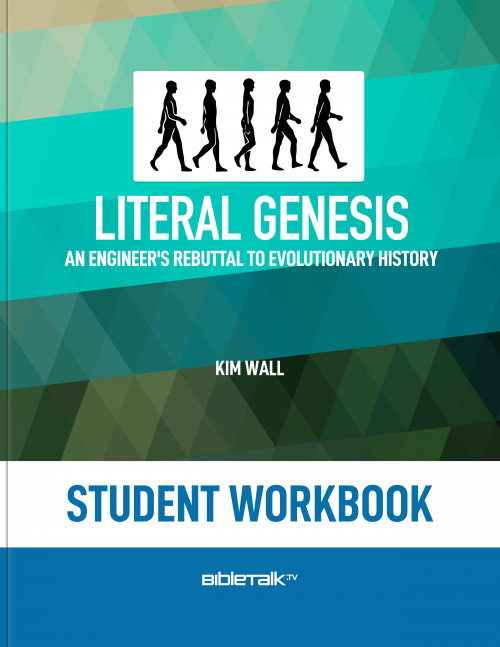Extreme Extinction Event!
Part 4 – Noah's Ark
Welcome to our next session of Literal Genesis, where here, as always, we strive to hold firmly to Scripture and loosely to theories, especially the theories that have to do with the past. Why is that? Well, because Scripture never changes. When we read in Genesis 6 about God giving Noah instructions on how to build the ark and why the ark was to be built and the impending flood that was going to destroy the earth, that's read the same for thousands of years. It hasn't changed. However, when we look at the past through a non-biblical lens, we're liable to have to change our theories all the time.
For example, it was believed that grasses, like the grass outside on the ground and in parks, that it didn't evolve until 10 million years after the dinosaurs disappeared and after they went extinct. That is, until they found at least five types of grasses in dinosaur coprolites, which is fossilized dinosaur manure, so when they find these things, they have to go back and they change their theories.
However, for those Christian Scientists who base their lens on Scripture, especially the early history in Genesis, they already knew. They already knew that God created the vegetation and the grasses on day three, and dinosaurs came on day six, so naturally, they would have known that dinosaurs would have been around the same time as grass.
In the last session we took a look at a possible mechanism for the flood. We looked at rapid or catastrophic plate tectonics, and we looked at a way to describe where we got the water, how it got on the continents, and how everything came to be buried. In this session, we're going to answer two questions, if we have time. One is about Noah's ark. How big was this ark? How did Noah get all the animals on the ark? And what kind of animals were included on the ark? And then, kind of a follow-up question, that is very similar, one we get all the time, and that is, were dinosaurs included on the ark? And if they were, what happened to them after they got off the ark? So those are the two questions we'll look at today.
Of course, we start with Scripture, and this is where we get our clues, so we want to make sure that we're viewing the past through the lens of Scripture or we're liable to have to change our own ideas, and in Genesis 6:20, we see,
"Of the birds according to their kind, and of the animals according to their kind, of every crawling thing of the ground according to its kind, two of every kind will come to you to keep them alive."
- Genesis 6:20
Now, I've got to say this: this does not seem natural, does it? Animals coming to Noah to be preserved? Does this sound natural to anyone? It doesn't sound natural to me. In fact, animals, whenever there's impending danger, whether it be a fire or a flood coming, or a hurricane or tornado, they don't stay around those areas. They tend to leave. They escape. But here we find just the opposite. There's an impending flood coming. Of course, it was a little ways out. And we'll ask a question about what these kinds mean here in a moment. They came to Noah. So I would call this a supernatural event. This was not natural. Animals don't behave this way naturally.
The reason I want to point this out is that during this Literal Genesis session, we've been looking at scientific theories. We've been looking at how science actually supports Scripture, right? We're not always going to be able to do that, are we? And in this, this is one of those examples where this is a supernatural event. Animals don't come to people to be preserved all on their own. And the reason that I bring this up is that we want to be careful, as Christians, that when we come across the supernatural readings like this, that we don't try to find a naturalistic or scientific reason to explain it. It's okay if you want to try, but I'm saying we don't really need to do that in these cases, where something supernatural has happened.
For example, in the virgin birth, science will tell you that's impossible. Well, we don't need to try to find a scientific explanation as to how Mary became pregnant, it's just going to be too difficult. Rather, it's going to be impossible. And we don't want to discount these supernatural events in the Bible either, and this is really the point is we don't want to compromise and say, "Well, it must not really mean they came to Noah."
We want to take this as it is, as it reads, "two of every kind came to Noah to be preserved." It's a supernatural event. So what did this ark look like anyway? It looked exactly like the image below. Well, actually I hope not.

There are so many things wrong with this depiction that it's kind of hard to know where to begin. If we start with the obvious, we've got big animals on this tiny little vessel. It doesn't look like there's a whole lot of room. I mean, how could he fit all of the animals that he would have needed to fit on there, two of every kind? That doesn't really look right. If we look at the waters there in the far right, they look tranquil. It's just kind of peaceful. Well, remember our last session. We looked at this idea of the fountains of the deep bursting forth and the floodgates of the heavens opening. This was not a tranquil event like this.
Obviously, you've got animals hanging off there, and just in general, they look far too happy, right? This looks like a pleasure cruise. That's not the idea we get from Scripture. Now, I get it. When we're teaching this to children, we obviously want to teach down to their level. I'm totally okay with that. I understand that. However, as children age and mature, how often do we go back and correct this image and then teach them exactly what Scripture says? It was not a pleasure cruise. This was a catastrophic event, a global deluge that killed billions and billions of living animals and creatures. It's no wonder that our kids, by the time they reach middle school, have already started to question the authority of Scripture because we, as parents, we have failed to go back and teach them according to their level as they mature. So I don't think this is an accurate picture, and we're going to look at Scripture to get a better idea of that.
But how did the animals fit on the ark? Well, actually, I think it comes down to a couple of things. One, how many animals are we talking about? Are we talking millions? Are we talking hundreds of thousands? Are we talking thousands? So that's one question that we need to get answered.
Another is the size of the ark. Was it like that bathtub ark we've just seen? Or was it immensely larger? Really, it comes down to math. Sorry to say, it's a math problem, right? We need to figure out the number of animals and the size of the ark to get an idea of how this might've been possible. The Scripture doesn't leave us without clues. We don't have to guess here. So naturally, we go to Scripture to look for those clues, and Genesis 7:15 says,
"So they went into the ark to Noah," this talking about the animals, "by twos of all flesh in which there was the breath of life."
- Genesis 7:15
Here we have our first clue. Animals that were preserved, or at least two of every kind, and when we read in other passages in Genesis where there were seven of other kinds, seven of the clean kinds, so there wasn't just twos; there was actually seven pairs of some of the others, that these animals had the breath of life in them.
Well, I'm not sure what that means, but that's a clue that we need to hang on to. Actually, if we kind of fast forward here a few verses to verse 22, Scripture says,
"of all that was on dry land, all in whose nostrils was the breath of the spirit of life, died,"
Genesis 7:22
So it's kind of coming together. We get the idea that the animals that were destroyed, who weren't represented on the ark, were land-dwelling, air-breathing creatures, and by air-breathing- the spirit of life- like in the nostrils, right? Breathe through the nostrils. So this would exclude some things right off the bat, like fish. Fish don't dwell on land, do they? They could survive a flood, although many, many marine creatures were buried during the flood, many would have survived. What about whales and dolphins? They breathe air, but again, they don't dwell on the land, so they don't qualify as this having a counterpart on the ark.
Things like insects- insects respirate differently than mammals, for example, you and I. They breathe in oxygen through pores in the skin. It's not the same as having nostrils, so we can eliminate some of these things, although I imagine plenty of insects would have hopped on the ark anyway, right? And insects have a way of surviving these catastrophes. They could survive on floating mats of vegetation, for example. We don't have to really explain the insects. It really comes down to these land-dwelling, nostril-breathing, air-breathing animals. These are the two clues that we want to go by, so this means that we would have needed to have two of every kind of dog, right? Two German shepherds, two spaniels, two bulldogs.
Now, this doesn't sound right. We need to key in on what this term kind is, because Scripture keeps talking about these kinds of animals. So we wouldn't need two of every one of these. In fact, today there's over 400 species of dogs. I don't know what Noah would have had in his day. He would have had probably more than three different species, so would he have needed all these different species of dogs? I don't think so. In fact, let's go back to Scripture. Let's get a little better understanding of this word kind. In 6:19-20, God's telling Noah,
"You shall bring two of every kind into the ark. Of the birds according to their kind. Of the animals according to their kind. Two of every kind will come to you to keep them alive."
- Genesis 6:19-20
Now, if we couple this with what we know about Genesis 1, when God created the entire universe and everything in it in six days. He rested on the seventh. He gave commands to the living things. He told the fish to multiply, be fruitful after their kind, the sea creatures. He told the land animals to do the same. The cattle kind, reproduce after your kind. Humans to reproduce after their kind. So we get the idea that a biblical kind is not necessarily a species, but something on the level of where you could still reproduce, and I'll make this more clear here in a moment because, the sole purpose of these animals coming to Noah was to keep them alive so that when they exited the ark after the global flood, they would have been able to reproduce and fill the earth again. That was the purpose. It has to do with reproduction within a kind, within a biblical kind.
Number of Animals
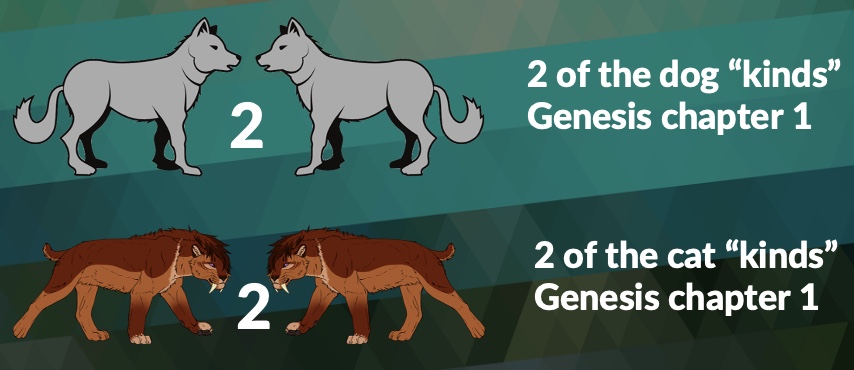
So going back to our dog analogy, we don't need all the different species of dogs. That's too specific. Instead, we would have just needed two of the dog kind that had within them all the genetic variability to produce all the species that we have today. In fact, scientists say those 400-and-some species of dogs we have today, they all came from one pair of dogs. That's what they say, looking at the genetics. Probably something on the order of a wolf is generally what's accepted here.
It is the same thing for cats. We don't need lions and tigers and cheetahs and all the different kinds of cat kinds. We just need two of the cat kind that, again, had all the genetic variability within them to produce the variety of cats that we have today. So automatically, you can see now that we don't need millions, right? We're kind of backing off of that number. When we back up a little higher to the level of kind, this number is probably much, much less.

John Woodmorappe has written a book called Noah's Ark: A Feasibility Study, and John is educated formally in biology as well as geology. I have this book. It's a very good book, easy to read, and he not only covers the possible amount of animals that Noah would have had to take on the ark, but he goes beyond that and talks about possible maintenance, how Noah and his family might've cared for the animals given the technology that they had and didn't have back then. The number that he's come up with, which a lot of biblical scholars would agree with, is somewhere around 16,000 animals.
If kind is what we would classify as a genus today- so if you think back to your high school biology and taxonomy. We've got species at the bottom. You've got genus. Then you have family, and as you go up, you have other things higher than that. So genus is not species, but it's kind of one step up.
If we go a step above genus to the family level, now we're talking around 2,000 animals. So this number is not as big as people might've thought. And when we look at the fossil record and we look at the- and this is what Woodmorappe has done in his book- extinct families in the fossil record. If you add those in, and then, all of the ones that we have today, it's probably going to be a number between 2,000 and 16,000. Generally, some biblical scholars say around 7,000 animals.
Regardless, let's just take the upper limit. Let's say 16,000 animals of this biblical kind is what Noah would have needed. The average size, again, from the fossil record, when we dig up remains of the fossils, we see the average size of these land-dwelling, air-breathing creatures would have been about the size of a rabbit or a dog, and this would have included the dinosaur families. It makes more sense to take the younger animals who would have been able to reproduce when they got off the ark. You don't need grandpa and grandma apatosaurus. You don't need grandpa and grandma T-Rex, right? All animals, including humans and dinosaurs and the reptiles of the past, they all started out very, very small. In fact, the dinosaurs came from eggs you could hold in your hand. Now, I'm not saying that Noah would have taken eggs on the ark, of dinosaurs, because remember, Scripture says the animals came to him, right? A male, female, they came to him. So it couldn't have been eggs. Eggs can't move. Even though that was a supernatural event, I think we can rule out eggs. So you would want to take animals who are on the verge of being able to be mature enough to reproduce, and by the time of the end of the flood, a year later, they would be able to reproduce when they got off the ark. So it just makes sense you would take the younger, healthier one.
What about the something like the apatosaurus? We know they got really big from their bones in the fossil record. In fact, somewhere on the order of 30 tons, 35 tons. These were really, really big reptiles. However, scientists have studied these growth rings inside of these apatosaurus bones, and what they have learned is that up until about age five, the apatosaurus weighed less than a ton, and it grew very, very slowly, but once it hit five, it grew on order of around five tons per year until it got to maturity at the age of 12 or 13. So why not take the four-year-old apatosaurus, right? It's very, very small. It took up a lot less space, ate less food, requires less maintenance. If Noah had to do much maintenance at all. There is this concept of hibernation that some scientists believe happened while the animals were on the ark.
Again, it could have been supernaturally imposed, But we want to take the smaller juveniles, right, is the key here. We don't need the gigantic dinosaurs, and when we narrow those down to the dinosaur kinds, there were probably less than 30 kinds, not all the species of dinosaurs that we know about today.
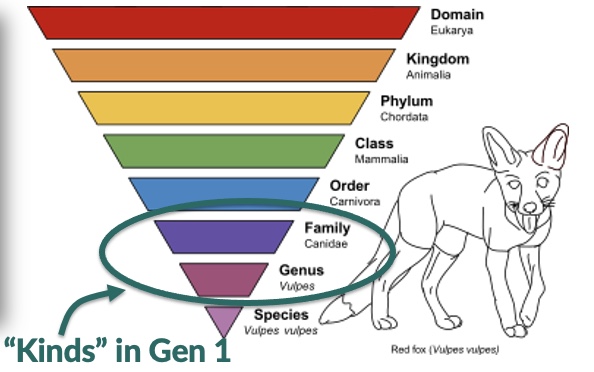
Again, just looking at the fossil record of what we know. So where does this biblical kind fit? I've got a chart here of the different taxonomy classifications of the red fox, and if we start very low down here at the species level, that's Vulpes vulpes. That's a red fox. Red foxes can reproduce with other red foxes. We know that. If we go higher up, to genus, to just Vulpes, we know that at this level, they could also reproduce, not only amongst themselves, but with other kinds of foxes, not just the red fox. If we go up one more to family, that's Canidae, this is where it gets interesting to me, is that at the family level, we still have the ability for these animals to reproduce. Well, what kind of animals are in the Canidae family? It would include foxes, dogs, wolves, coyotes, jackals, dingoes, right? All these things we know, many of them can reproduce today at that level, so wouldn't it make sense for Noah to have two of the family of Canidae, what we would call the Canidae family, instead of going down here at the species level, which would be really broad, too specific, so it's generally thought that biblical kinds is somewhere between the genus and the family level.
That's where we get the numbers of either 16,000 at the genus or 2,000 animals at the family level, okay? Now, I've had the argument brought up that there's really no way to know for sure what a biblical kind is, and we should be ultra-safe and go by species. Okay, so let's do that, just as an exercise. I have a chart here of the air-breathing, land-dwelling type of animals that Noah would have preserved on the ark: reptiles, birds, amphibians, and mammals, even though all the amphibians may not have qualified there, but we're going to include all of them.

Now, this is a modern number that we're going to look at here. Again, no fish, no whales, no dolphins, no insects. We don't need those. No fungi, right? Those don't qualify, but these do, and if we look at these numbers, and we add them up, this is from the IUCN, by the way. If you've heard of the IUCN Red List, that's the endangered species list, this is where this comes from, but these aren't endangered. These are just numbers of species that have been cataloged today. We come up with about 32,234 species of these types of animals that, if we looked at today's numbers, this would be the number that Noah would have had to take on the ark, so either 2,000 or 16,000 or 32,2000, right? Those are the ranges that we have to work with.
So we'll go back to Scripture. Let's get a little more information. Now we need to figure out, now that we kind of have a number in mind, well, how big was the ark? Is it going to be large enough to house all the animals? And Genesis 6:15 says,
"This is how you shall make it: The length of the ark shall be 300 cubits, its width 50 cubits, and its height 30 cubits."
- Genesis 6:15
Now, we all know what a cubit is, right? We use it every day. Actually, we don't use it every day. We kind of have to go back in history to get an idea of a cubit, and it was used all throughout ancient history, not only by the Hebrews, but by the Egyptians as well, and we have different measurements here, depending on the era.
In fact, Ezekiel, when he was told to make the altar, he was told to make it a cubit and a hand width, so it was a cubit plus a little bit more. I don't think we're dealing with that size of a cubit, but if you look here, these aren't greatly different, so we generally use this common one when we think about Noah, and the cubit that he would have used has been about 18 inches. If that's true, and this is probably a safe bet, we don't want to go too high, then that would put the ark with these dimensions: 450 feet long, 75 feet wide, and 45 feet high.
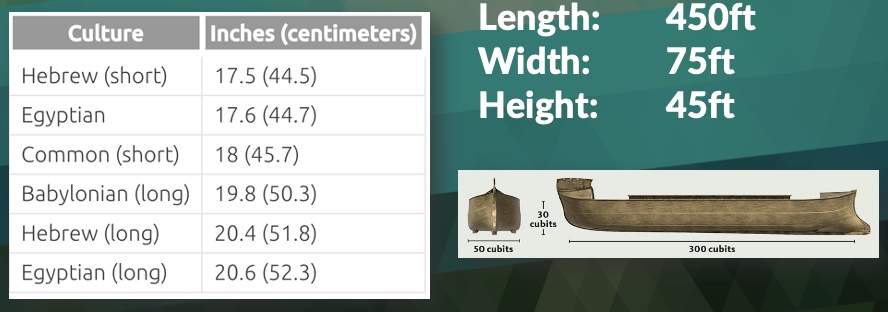
Do these measurements seem like a little bit larger than that picture we saw earlier, with all the animals crowded on the ark? To me, this seems like a bigger vessel. We kind of have a picture here, not that this was exactly how it looked. We don't know exactly how the design would have been, but these are the dimensions. It would have been a really, really large vessel. And if you picture this with the three decks that God told Noah to put inside of it. This is not a bathtub toy. This is not the size of the ark we see in our children's book, is it? It's much, much larger.
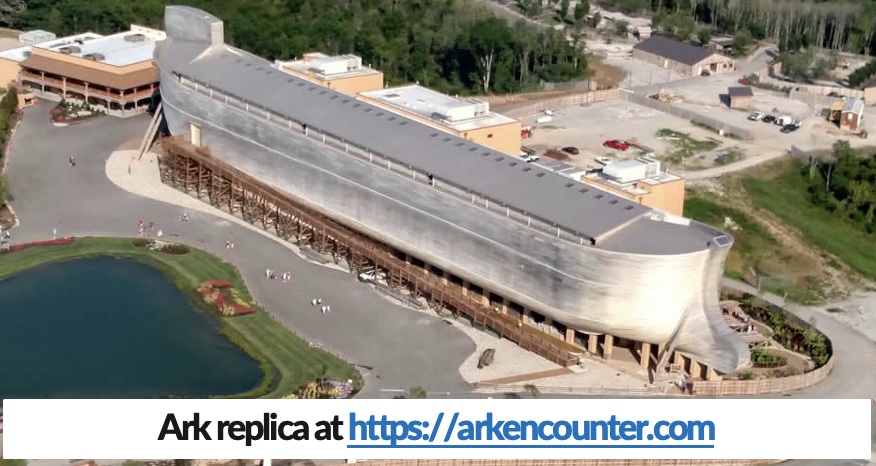
In fact, you can see a full-size replica using the 18-inch cubit, I believe that's what they used, in Williamstown, Kentucky (arkencounter.com). They have built a life-size replica. Notice the people here for scale. This was a big, big vessel. Well, was it big enough to carry all the things that needed to be carried? That's the question we're trying to figure out. In order to do that, we have a little bit more math to do, but don't worry. We won't have to do the math. The math's already been done for us.
If we think about the size of the ark, and then compare that to standard railroad shipping containers that you would see on railroad tracks tied together, one after another, given these dimensions of the ark, just general math tells us that it could hold a minimum of about 522 of these railroad boxcars. That's a lot of boxcars. And then, if we think about this average size of animal that Noah would have had to have maintained in there, about the size of a rabbit or a dog or even a sheep size, we can fit 120,000 sheep-size animals inside of these containers, which would have been enough to fill the ark. That's a lot of animals, 120,000 animals, but we only needed to carry, remember, if that biblical kind was equivalent to genus, we're talking about 16,000 animals, but even if we use today's species number of 32,000, do we have enough room? We have more than enough room.
In fact, it would seem some of the animals might've even gotten to get out and jogged around the deck. Maybe it was kind of like... No, it wasn't a pleasure cruise at all, but there would have been so much more room than was needed. In his book, John Woodmorappe explains how some of that room might have been used, possibly for exercising and those sorts of things.
Obviously, you've got food storage. Noah was to take a representative of every kind of fruit and plant for storage as well as food for the animals, so there was enough room for the animals. There was enough room to store the food and the water that would have been needed, although he could have caught the water from the rain, right? And stored that.
All right, so let's sum it up. We've got more than enough room, given the biblical dimensions of the ark and what we know about the number of animals. It would have been 16,000 or less, and the size of the ark could have held 120,000 of these sheep-sized animals, which the average animal might've been even smaller than that.
What Happened to the Dinosaurs - Top Three Theories

Okay, so we've answered two very important questions. We think the ark would've worked, right? Now, what happened to the dinosaurs? If two of every kind, including the dinosaur kind, came to Noah to be preserved, that would obviously include the dinosaurs, so we know that the rest, who weren't on the ark, they were buried, and we find their bones all over the globe today, billions and billions of those things. So what happened to those representatives that got off the ark? They obviously aren't alive today.
Many species that got off the ark do have a modern-day counterpart. They're still alive. So what happened to these dinosaurs? Let's look at the top theories, the top three. We'll do this pretty quickly here. You've probably heard of these. Number one at the top of all the lists is this: meteorite impact. So a meteor about 7 1/2 miles wide traveling at 27,000 miles an hour smacked into Earth, and obviously, that would've kicked up a lot of debris, a lot of cloud, a lot of dust, and that would have blocked the sun- these particles, these fine dust particles- and it would have blocked it for a really long time, so maybe that changed the climate, blocked the sun, it got colder, reptiles being warm-blooded, they need the warm environments. That's one. And by the way, this theory, even though it's number one on the list, the location that this meteorite was supposed to have hit is Mexico, Chicxulub, Mexico. There's a lot of controversy these days about whether or not that was an actual meteorite.
Now it's generally believed that that's a site of a massive volcano because of the iridium that's found there. You find iridium in meteorites and volcanic debris as well, but anyway, it's not a done deal. Nobody knows because it was the past. Unfortunately, Noah's descendants didn't record what happened to the dinosaurs, so we don't know. I think I just gave the whole thing away right there, right?
What's the second one? The second one's a food shortage. We kind of see some of that now as we go to the grocery store. We see a shortage of some things. But the idea here is that, again, probably a meteorite or a volcano kicked up massive particles in the air, and food sources died out, so the dinosaurs died out along with it.
The third most popular is really kind of along the same lines: massive supervolcanoes. Now, when we look at the fossil record, we do see evidence of these volcanic activities, of which we have never seen the likes of. Mount St. Helens is a drop in the bucket compared to some of these volcanic explosions we see in the fossil record. Super-super-massive volcanoes, and again, kicked up lots of gases and dust, and blocked the sun, and it would have affected the climate, would have affected food.
Now, it wasn't just the dinosaurs that went extinct. Scientists believe that whatever caused the dinosaurs to go extinct, also caused around 80% of all life to become extinct. Now, I think they're really close right there, right? Because if we go back to the flood history in Genesis, it's a big number of animals that died, that were were affected, and then a few, 16,000, that would have survived the flood, so it was a mass extinction event, for sure.
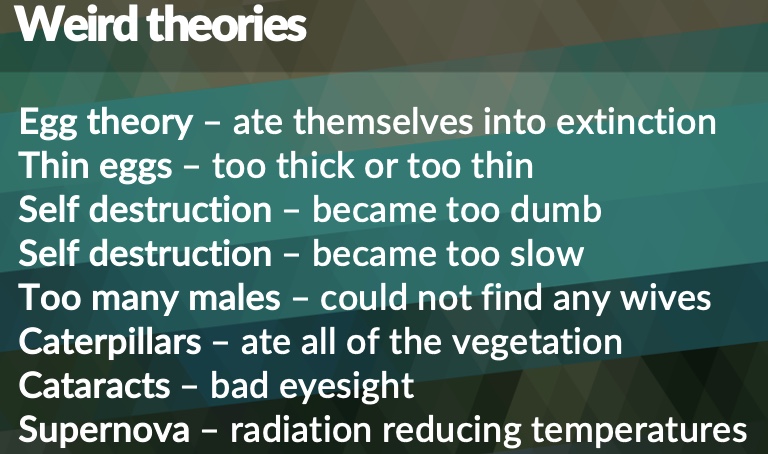
Some of the other more strange theories, and what I want to point out here is that these are written in scientific papers by scientists, and they're not just made up by anybody on the street. Some interesting ones. For example, the egg theory: that the shells of the eggs of the dinosaurs, they became too thick, couldn't allow oxygen in, so the baby dinosaur couldn't make it, or they became too thin.
Actually, that's not this theory. This theory has to do with eating eggs. Sorry, I'm getting ahead of myself. What this theory proposes is that T- Rexes loved to eat eggs of the sauropods, and so they kept eating them and eating them until there were no more baby sauropod eggs to be hatched, and the sauropods went away, and once the sauropods went away, what was T-Rex going to eat? Because supposedly, there wasn't a lot of mammals around during this time, just very tiny ones, so they ate themselves into extinction.
Here's the thin egg one: the shells were either too thick or too thin. Again, probably caused by some type of climate change. That's the general idea. It got cold, and that affected the eggs, the shells.
Self-destruction, this is mutations and natural selection at work. Now, we had several series on mutations, so hopefully, this is familiar, but they were very unlucky. They had some very bad mutations, and it affected their intellect or affected their speed, and they died out. They were chosen for extinction by natural selection.
Too many males. This one, again, is kind of related to climate change. It got really cold somehow, and this affects the cell, the sex of the males, right? You have too many males, and so they couldn't find any wives. They had no girlfriends to go date, marry, and grow up and have children with.
Caterpillars. This is one of my favorites. The caterpillars ate all the vegetation, so we had a massive spurt of growth of caterpillars that ate all the vegetation. Well, what were the herbivores going to eat? Well, they died out because there was no food, and then what were the carnivores going to eat, because their food source ran out all due to those caterpillars.
Cataracts, bad eyesight. This one has to do with, not the climate turning cold, but just the opposite: The sun was too hot, and so before the dinosaurs could reach reproductive age, they went blind, and now they couldn't see. This is an actual theory.
A supernova. There was a nearby star that exploded and just blasted the Earth with all kinds of radiation and X-rays, and this caused them to go extinct, not just the mutations, but reducing the temperatures on Earth as well.
There are lots and lots of theories here, but Robert Bakker kind of sums it up nicely. He says,
"Traditional dinosaur theory is full of short circuits. Like the antiquated wiring in an old house, the details sputter and burn out when specific parts are tested."
- Robert T. Bakkar
The Dinosaur Heresies, 1986
What's he saying here? He's saying when it comes to what happened to the dinosaurs, which is- it's a good question to ask. It's an important question. But the theories just come and go, and there's so many of them. In fact, there are over 160 published theories. Now, many of them are kind of falling out of popularity, but overall, there's a lot. What does this tell us with so many different theories? It really means we don't know, and again, Noah's descendants didn't record for us what happened to every animal kind after they got off the ark and started reproducing.
There's more than just the dinosaurs that went extinct. In fact, in the last 100 years, recent history, IUCN has recorded over 1,000 species that have become extinct. Now, this is a very, very generous number because they're only taking into consideration the species that have been cataloged. There are on the order of several million species that haven't been cataloged, and when you add those in here, we actually have daily extinction events. That's what the IUCN tells us. The other interesting thing about this is that 1,000 species that have gone extinct, have done so largely coinciding with the effort of humans to prevent this.
Even in my lifetime, I've read about lots of species that have gone extinct, and this is with great effort on the behalf of IUCN to not let it happen, and it happens anyway. So it's not just the dinosaurs, right? Species go extinct all the time, even when we do our best, as humans, to prevent that.
So kind of bringing it back around full circle. Why? Why would God go through this event, a year-long event, not counting the time Noah spent the year building the ark, going through the flood, going through the fountains of the deep bursting forth, the floodgates of heaven, all of this, to preserve the animals on the ark and to kill so many living things, including the humans that were not on the ark? Why would He go through this great length to do that? Well, let's go to Scripture to get an idea. Genesis 6:5,
"Then the Lord saw that the wickedness of mankind was great upon the earth." Wickedness is not good. God hates wickedness. He hates sin. He goes on, "and that every intent of the thoughts of their hearts was only evil continually."
- Genesis 6:5
Now, I think about this verse a lot. We see evil in the world today. We have people that are malicious. We have people that do good, but I wouldn't say that every human that I meet only has evil continually, that their intentions are only evil. So we're talking about a time and period where people were really, really selfish, and they were really doing bad things. He goes on in verse 7,
"Then the Lord said, 'I will wipe out mankind, whom I have created, from the face of the land,'"
- Genesis 6:7
I don't want us to miss the point here. We started out asking the question: How could Noah have fit the animals on the ark? We answered the size of the ark, the biblical kinds, but I don't want to miss the point, and that is this: that is, God really hates sin, and He judges sin, and He punishes sin. So the flood is a picture for us of God's judgment, His righteous judgment.
On the other hand, it's also a picture of salvation because Noah, his wife, his three sons, and their wives, eight people in all, they were saved. Why? Why just this small group of people? Well, in Genesis 6, Scripture says that,
"Noah found favor in the eyes of the Lord."
- Genesis 6:8
So even amongst all this wickedness and evil going on, which God hated, and He had to judge because He is just, He is also able to save those who obey Him. That's the picture that I want to leave us with today.
Now, in our next session, we're going to take a look at the age of things, so we've kind of been skirting around this idea of age, and why do things look old? And why do fossils date so old? Why do rocks date so old? Why do we have starlight coming from so far away? If the earth is really about 6,000 years old, along with the universe, then how do we reconcile this with a biblical lens? That's what we'll take a look at in our next session.
Thank you so much.



